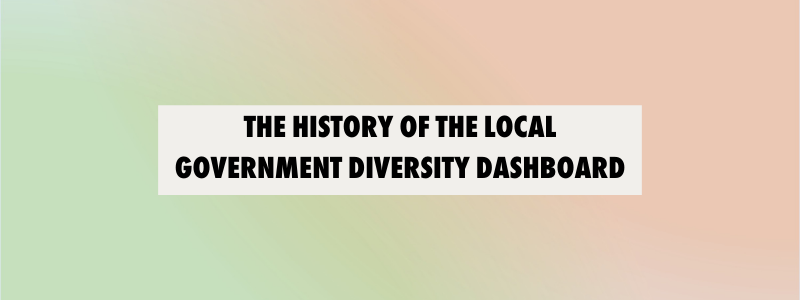
Today’s Morning Buzz is by Kirsten Wyatt, the ELGL co-founder and executive director. Connect with Kirsten on Twitter and LinkedIn!
- What I’m Reading: Maus by Art Spiegelman
- What I’m Watching: The Marvelous Mrs. Maisel Season Four
- What I’m Listening To: Wild Boys
I’m joining my fellow Morning Buzz writers by focusing today’s Buzz on the release of the newest iteration of the Local Government Diversity Dashboard. Please take a minute and check out these excellent posts by Amie, Sarah, and Brianna, and please consider signing up to write you own reflection on the DiversityDashboard.org data. We’re republishing posts on both ELGL.org and Diversity Dashboard.org.
- A Woman in Charge – Sharing the Leadership Pie
- All the Single Ladies
- Gender Equity in Local Government: Clerks
This is an overview of ELGL’s work on the Local Government Diversity Dashboard. This work started in 2015-2016 from our interest in having a publicly available data dashboard to tell a story about the state of local government leadership diversity.
Glacial Pace
After the International City/County Managers Association (ICMA – a professional association for city and county managers and administrators) released their 2015 data on the percentage of women leading communities, and the lack of progress that had been made, ELGL jumped into the conversation about the lack of gender diversity in the top position in local government organizations.
#13Percent
We began using the hashtag #13Percent to characterize the low percentage of women in leadership, and also the lack of progress that had been made. This hashtag drove ELGL articles, conference sessions, podcasts, and webinars about the ways we could ensure that local government leadership reflected their communities. Around this time we also started to have conversations about how it would be powerful and impactful to not only share gender data, but also race and ethnicity, and age data too. We also began to look at the fragmented and siloed nature of local government data, often kept by different associations, different states, or on a membership basis and how the larger local government community lacked one centralized place to share data regardless of job title, professional association, or region.
Crowdsourced Funding
In 2018 we crowdsourced funding to begin collecting demographic data on city manager and administrator positions and hired a team of graduate students to administer surveys and compile results. This early effort resulted in approximately 2,500 responses, but often only from individuals who shared ELGL’s vision of emphasizing and amplifying diversity, equity, and inclusion work. We are grateful to our funders who got this effort off the ground, to showcase that the collection and sharing of demographic data is something that the ELGL and the larger local government community cared about.
Early Dashboard Surveys
ELGL continued to collect and share data from surveys, but continued to face the same data collection methodology challenge of people self selecting to participate. Our goal of a region and association agnostic approach to share demographic data seemed like a costly and time intensive process. While our content and information related to gender diversity in local leadership continued, it was frustrating to not be able to grow the number of Diversity Dashboard responses year over year.
Power Almanac
ELGL and PowerAlmanac teamed on an effort to assist women and minority owned businesses that work with and for local governments. Through this partnership, we realized we share organizational values about getting more women and people of color into local government leadership. PowerAlmanac connected ELGL to a then-new non-profit organization that also shared an interest in DEI and also local government open data. Plus, Power Almanac keeps a census of 16 local government leadership positions, which opened our eyes to the possibility of expanding our Local Government Diversity Dashboard efforts beyond just the top leadership position, to potentially include all leadership spots.
CivicPulse
CivicPulse and ELGL were introduced and it was a match made in heaven. As local government serving non-profit organizations, we both share a vision that local government data should be freely and easily accessible so local government issues can be researched, understood, and shared. The CivicPulse team shared their recent developments in data collection and probabilistic name-based gender coding to develop a rigorous methodology that can provide dynamically updated benchmarks on the gender composition of top local government-appointed officials (e.g., manager, administrator, etc.) for all municipalities, townships, and counties with populations of 1,000 or more. More information on the methodology and plans for future data releases are available here.
Qualtrics
Thanks to a generous grant from Qualtrics, we were able to array, analyze, and share data on the top appointed official position in local governments. This is meaningful and important research, and we are hopeful that we can continue to add positions, data, and engagement to the Local Government Diversity Dashboard with future investments by other supportive partners.
2022 Local Government Diversity Dashboard
We are excited to re-release gender data for more than 21,000 local governments and their stakeholders across the country pursuing diversity, equity, and inclusion (DEI) initiatives: the Local Government Diversity Dashboard (LGDD). Built with groundbreaking data science and analysis, LGDD’s interactive maps and charts and the “2022 Local Government Leadership Gender Gap Report” offer an unprecedented look at the gender composition of top appointed leaders across the country.
Key features of DiversityDashboard.org:
-
- Lookup your community (city, county, or state) from more than 21,000 communities
- Map your region or condition with granularity going down to the township level
- Chart changes over time by any state or Census region within the database
- Learn more about the important DEI work in local governments nationwide
We are hopeful that you will take some time to peruse DiversityDashboard.org. Please consider signing up to reflect and write about the data and what you see in it. Where are some areas where we need improvement? What are some trends that you think are meaningful?
